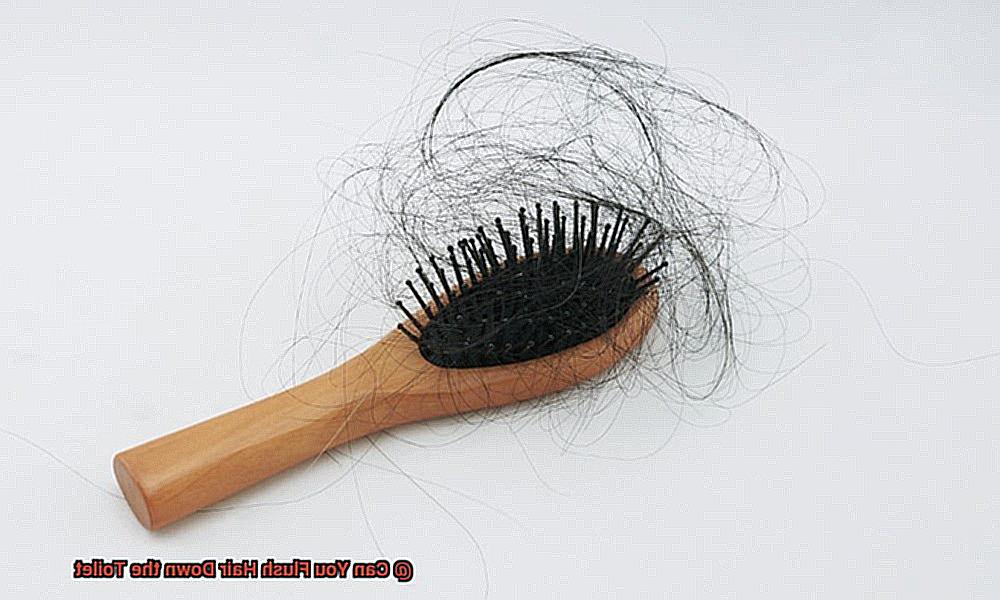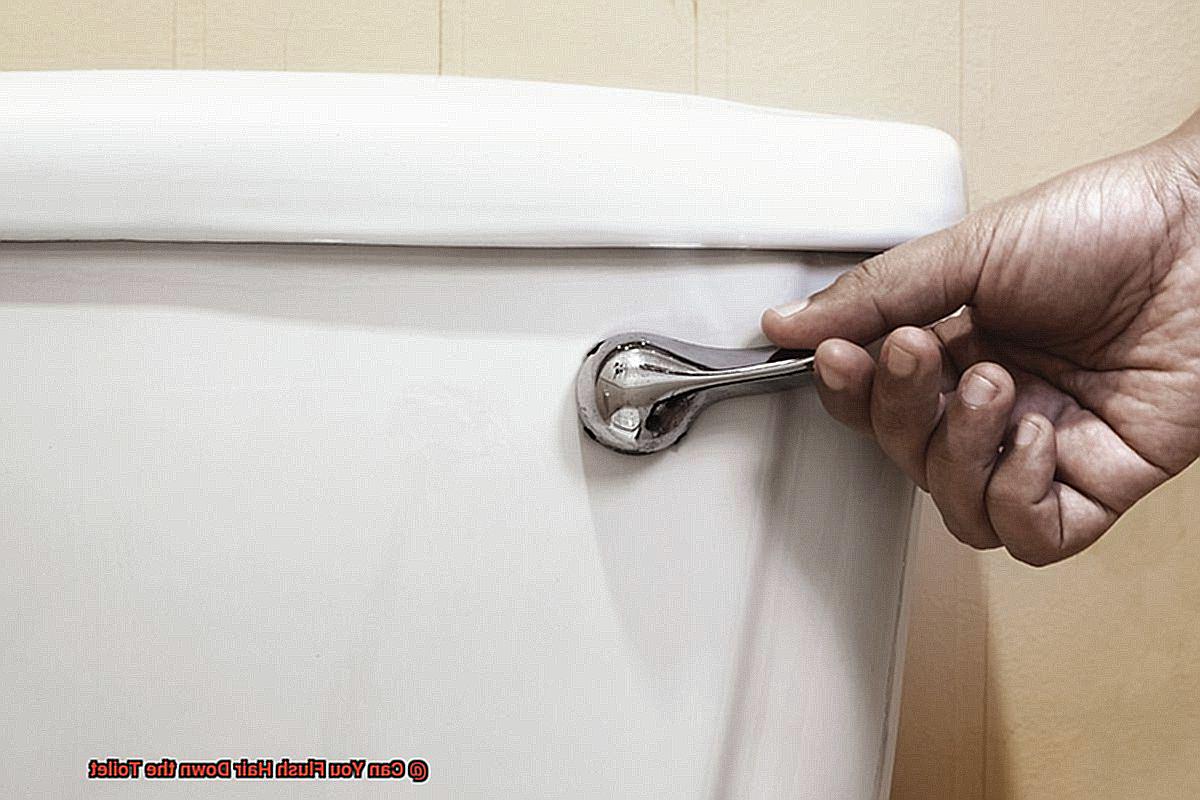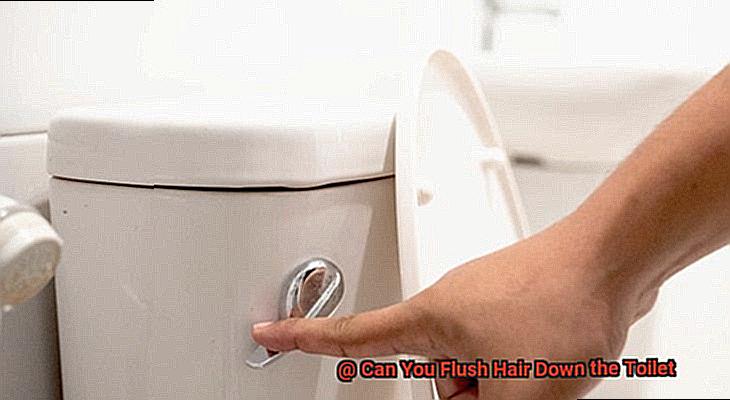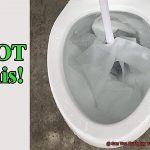If you have long hair, you know the struggle of cleaning and disposing of it properly. The tangled mess can be a headache to manage in the shower or on the bathroom floor. But when it comes to disposing of it, confusion might arise about what is appropriate. Can you flush hair down the toilet? It seems like an easy solution, but is it really safe?
In this blog post, we’ll explore the potential consequences of flushing hair down the toilet and whether it’s a viable option. Let’s start by understanding how the plumbing system works. Although hair may seem small and harmless, it can cause blockages in pipes and even damage septic systems. These issues can be costly to fix and disruptive to daily life.

Plus, flushing hair down the toilet has environmental consequences too. Hair doesn’t break down quickly and can end up in bodies of water, harming aquatic life. So before you reach for that flush handle, consider alternative methods to dispose of hair safely and effectively.
Fortunately, there are practical solutions that make hair disposal less of a headache. We’ll discuss some of these alternatives so you can say goodbye to tangled messes without causing harm to your plumbing or environment.
So if you’re wondering whether you can flush hair down the toilet, keep reading. We’ve got all the information you need to make an informed decision about proper hair disposal.
Contents
Why You Should Not Flush Hair Down the Toilet
It may seem like a convenient way to dispose of your locks, but it’s actually a harmful practice that can lead to a multitude of problems.
Firstly, hair is not biodegradable, meaning it doesn’t break down easily in water. This can cause significant issues for your plumbing system. When hair is flushed down the toilet, it can get tangled up with other debris in your pipes, creating blockages and clogs that can be expensive to fix. Over time, the hair can also stick to the sides of your pipes, causing buildup and further complications.
But it’s not just your plumbing that’s at risk. Flushing hair down the toilet can also harm the environment. When hair enters waterways, it can harm aquatic life by clogging up their gills or digestive systems. And in sewer systems, hair can contribute to the formation of “fatbergs” – massive clumps of non-biodegradable materials – that can cause significant issues for wastewater treatment facilities.
To avoid these problems, it’s important to dispose of hair responsibly. Instead of flushing it down the toilet, invest in a hair catcher for your shower or bathtub drain. These simple devices trap hair before it has a chance to make its way into your pipes, preventing costly repairs and potential health hazards down the line.
Remember: the toilet is not a trash can. By taking simple steps to dispose of hair properly, you can ensure that your plumbing system runs smoothly and do your part to protect the environment.
The Damage Hair Can Cause to Your Plumbing System
It may seem like a harmless act, but over time it can lead to significant damage to your plumbing system. Hair easily gets caught in pipes and creates stubborn blockages that stop water from flowing freely. These blockages can be difficult and expensive to fix.
But that’s not all – when flushed down the toilet, hair can accumulate in pipes and create a breeding ground for harmful microorganisms. This can cause foul odors and even health problems if left unchecked. Additionally, hair can react with other materials in your plumbing system, such as soap scum and mineral deposits, creating hard, sticky clumps that are almost impossible to remove.
Over time, these blockages and clumps can put pressure on your pipes, causing them to crack or burst. This not only results in costly repairs but also potential water damage to your home.
Fortunately, there are ways to prevent this damage. Simply dispose of hair properly by collecting it in a waste bin or composting if possible. And if you do accidentally flush hair down the toilet, act quickly to address any blockages or backups before they cause further damage to your plumbing system.
How Hair Can Clog Pipes and Septic Tanks
You may think it’s harmless, but in reality, it can cause significant damage to your plumbing system and septic tank. Flushing hair down the toilet can create a tangle of hair and other materials such as toilet paper, grease, and debris that can block water flow in your pipes.
Over time, this blockage can become more severe and lead to slow draining sinks and toilets, backups, and overflows. In some cases, the blockage can even cause pipes to burst or rupture, leading to costly repairs. But that’s not all, hair doesn’t break down easily in water and can accumulate in your septic tank over time.
Such accumulation can lead to clogs and backups that can be difficult and expensive to fix. It’s best to avoid flushing hair down the toilet whenever possible. Instead, dispose of it in a trash can or compost pile.
If you need to remove hair from a drain, use a drain snake or another tool specifically designed for this purpose rather than relying on flushing it away. By taking these simple steps, you can prevent costly plumbing issues and keep your septic system running smoothly.
Remember: prevention is key. So keep your pipes clear by avoiding flushing hair down the toilet and disposing of it properly.
The Cost of Repairing Clogged Pipes
What may seem like a harmless act can actually lead to costly repairs and potential damage to your plumbing system.
Hair flushed down the toilet can accumulate in pipes and cause clogs, leading to water backups and slow draining sinks and toilets. If left untreated, clogged pipes can result in costly repairs that vary depending on the severity of the blockage and its location.
While homeowners can attempt to unclog their pipes using a plunger, drain snake, or chemical drain cleaner, these methods may not always solve the issue. In severe cases where flushing hair down the toilet has caused damage to pipes or sewer lines, a professional plumber may need to be called in. The cost of hiring a plumber to fix clogged pipes can range from $100 to $800 or more, depending on the extent of the damage.
Unfortunately, clogs caused by negligence on the homeowner’s part are typically not covered by insurance policies. This means that if a clog occurs due to flushing hair down the toilet, homeowners will be responsible for covering the cost of repairs out of pocket.
To avoid costly repairs and potential damage to your plumbing system, it’s best to avoid flushing hair down the toilet altogether. Instead, dispose of hair in a trash can or compost pile and take preventative measures such as using a drain snake regularly.

It’s important to note that in some cases, clogs caused by flushing hair down the toilet can be so severe that pipe replacement is necessary. This can cost thousands of dollars, making it all the more important to take preventative measures.
Alternatives to Flushing Hair Down the Toilet
Flushing hair down the toilet may seem like a quick fix, but it can lead to costly repairs and potential damage to your plumbing system. Fear not, as there are several alternatives to flushing hair down the toilet that can help you avoid these problems.
One of the most common alternatives is using a drain catcher or strainer. These nifty devices are designed to catch hair and other debris before it goes down the drain. They are affordable and easy to install, making them an excellent option for anyone looking to prevent clogs and other plumbing issues. Plus, they come in various shapes and sizes to fit any drain.
Another easy alternative is to use a trash can. Instead of flushing hair down the toilet, simply collect it in a small trash can and dispose of it properly. This method is simple and effective, and doesn’t require any special equipment, making it ideal for anyone looking for an easy way to prevent clogs. Plus, it’s environmentally friendly.
Do you have a furry friend at home that sheds frequently? Consider using a pet grooming tool to remove loose hair from your pet’s coat before it falls out and ends up in your drains. By using a pet grooming tool regularly, you can significantly reduce the amount of hair that ends up in your plumbing system. Not only will this help prevent clogs, but it will also keep your pet’s coat healthy and shiny.
If you’re dealing with a particularly stubborn clog or need professional help with your plumbing system, don’t hesitate to contact a licensed plumber. They can help you identify the cause of the clog and provide effective solutions to prevent future problems. Plus, they have all the necessary equipment and expertise to get the job done right.
Investing in a Hair Catcher for Your Shower or Bathtub Drain
These handy devices are specifically designed to trap hair before it makes its way down the drain and causes a blockage that could result in costly repairs.
There are various types of hair catchers available on the market, ranging from simple mesh screens to more complex designs with suction cups or adhesive backing to stay in place. Some models even come with built-in brushes, making it easy to clean out trapped hair and other debris.
When choosing a hair catcher, it’s crucial to consider factors such as durability, ease of use, and compatibility with your specific drain size and configuration. Look for models made from high-quality materials and with positive customer reviews.
Investing in a hair catcher may seem like a small and simple step, but it can go a long way towards maintaining a reliable and efficient plumbing system. By taking proactive measures to keep your drains clear of hair and other debris, you can prevent costly plumbing issues from occurring in the future.
Don’t wait until you have a clogged drain – take the necessary steps today to keep your pipes flowing smoothly. Trust me, it’s much easier to prevent plumbing problems than to fix them after they occur. And if all else fails, don’t hesitate to call in the professionals who have the necessary equipment and expertise to get your plumbing system back on track.
Overall, investing in a hair catcher is an inexpensive and straightforward way to maintain your plumbing system’s health. Your wallet will thank you for avoiding costly repairs, and your peace of mind will thank you for having one less thing to worry about.
0qOljXNeVnc” >
Conclusion
In conclusion, while it may be tempting to flush hair down the toilet as a quick and easy solution, it’s important to consider the potential consequences. Hair is not biodegradable and can cause serious damage to your plumbing system if it gets caught in pipes or creates blockages. Not only can this result in costly repairs, but it can also harm the environment by clogging up waterways and causing harm to aquatic life.
Thankfully, there are several alternatives to flushing hair down the toilet that are both effective and affordable. Installing a drain catcher or strainer is a simple yet effective way to prevent hair from going down the drain. Alternatively, collecting hair in a trash can or compost pile is another eco-friendly option.
If you’re looking for a more long-term solution, investing in a high-quality hair catcher specifically designed for your shower or bathtub drain is an excellent choice. When selecting a hair catcher, consider factors such as durability, ease of use, and compatibility with your specific drain size and configuration.
Ultimately, taking proactive measures to properly dispose of hair can save you time, money, and hassle in the long run. By adopting these simple practices, you’ll not only protect your plumbing system but also contribute to a cleaner and healthier environment.






